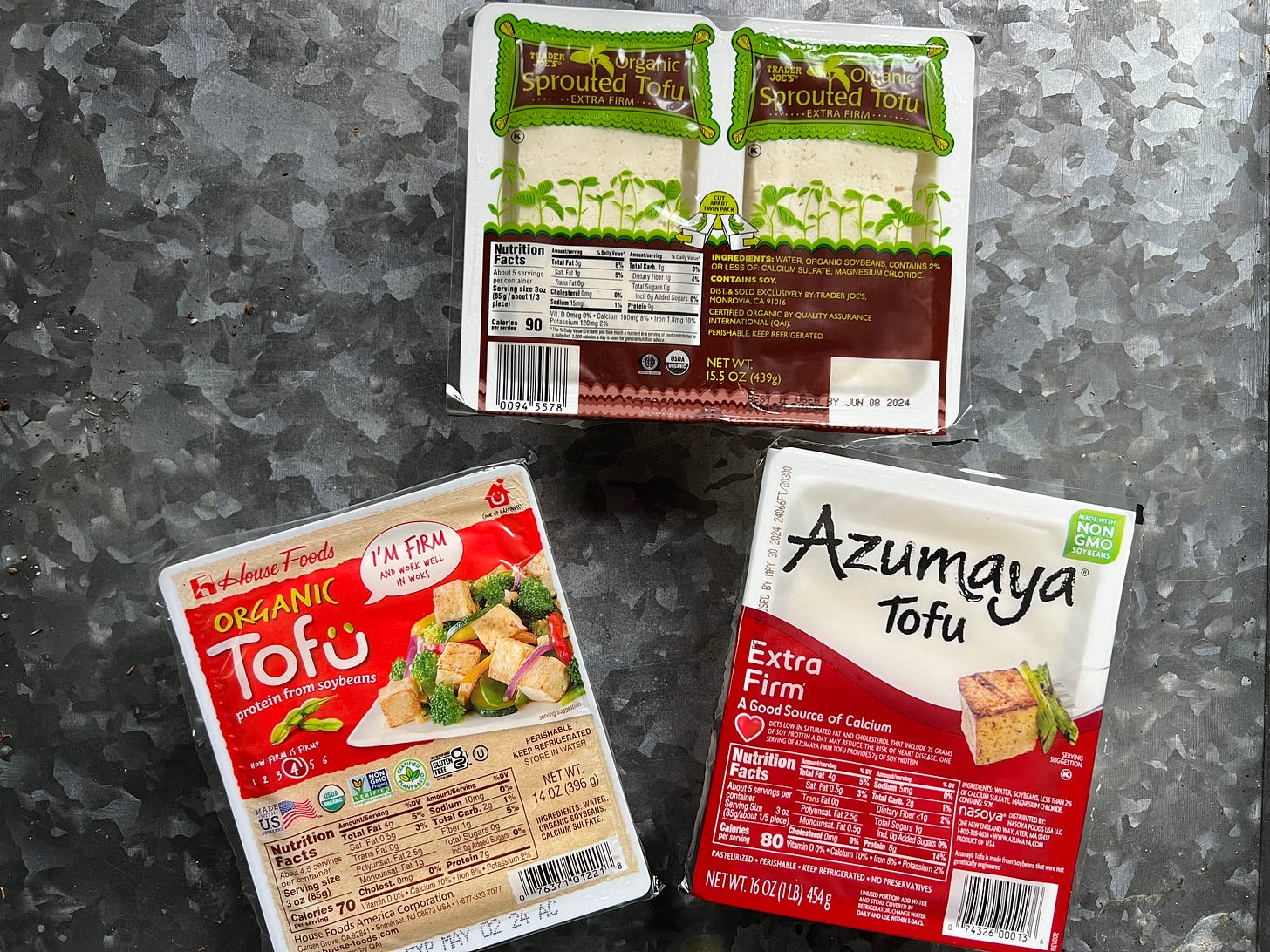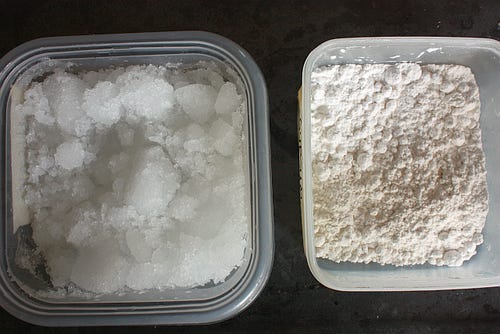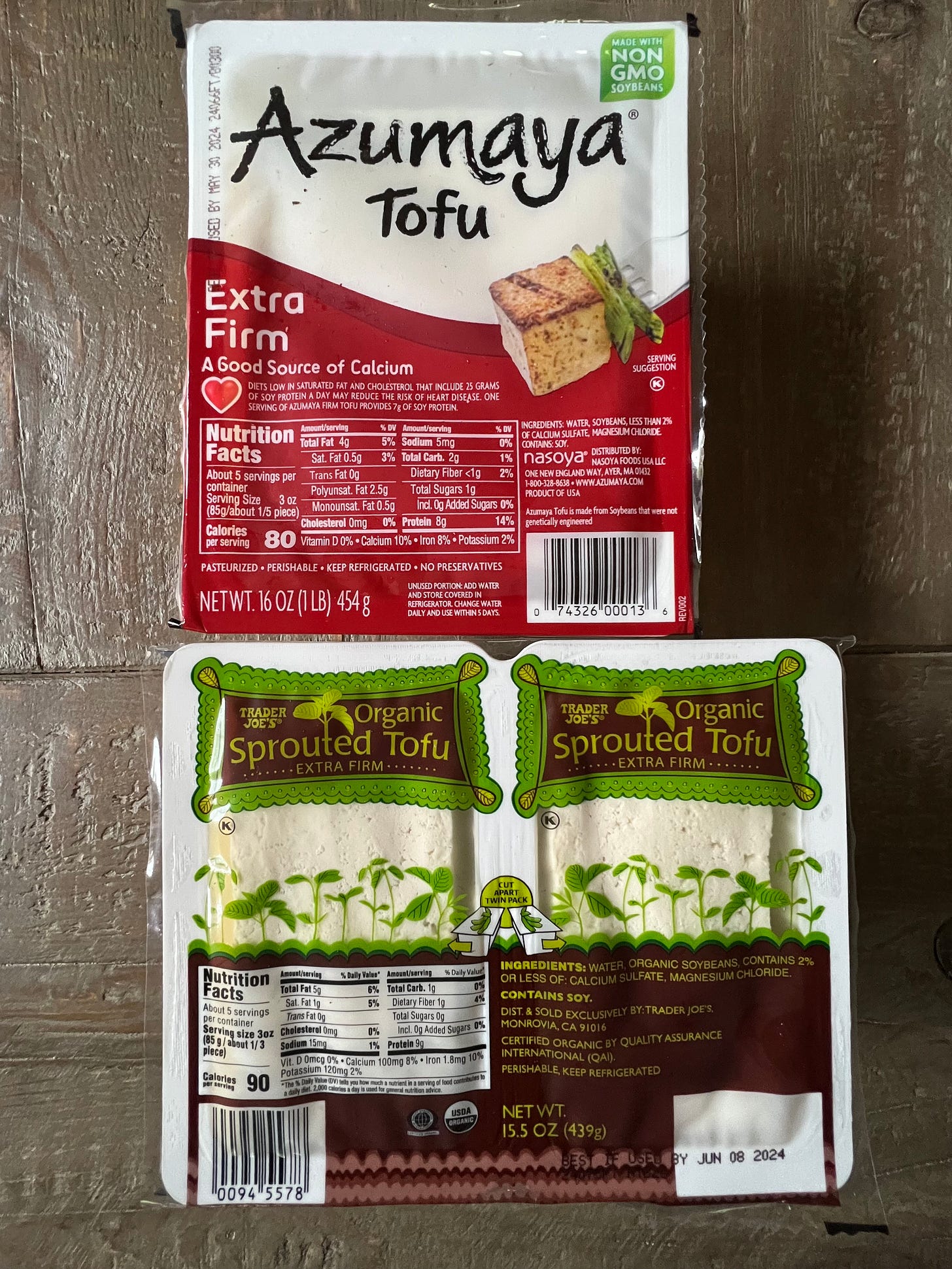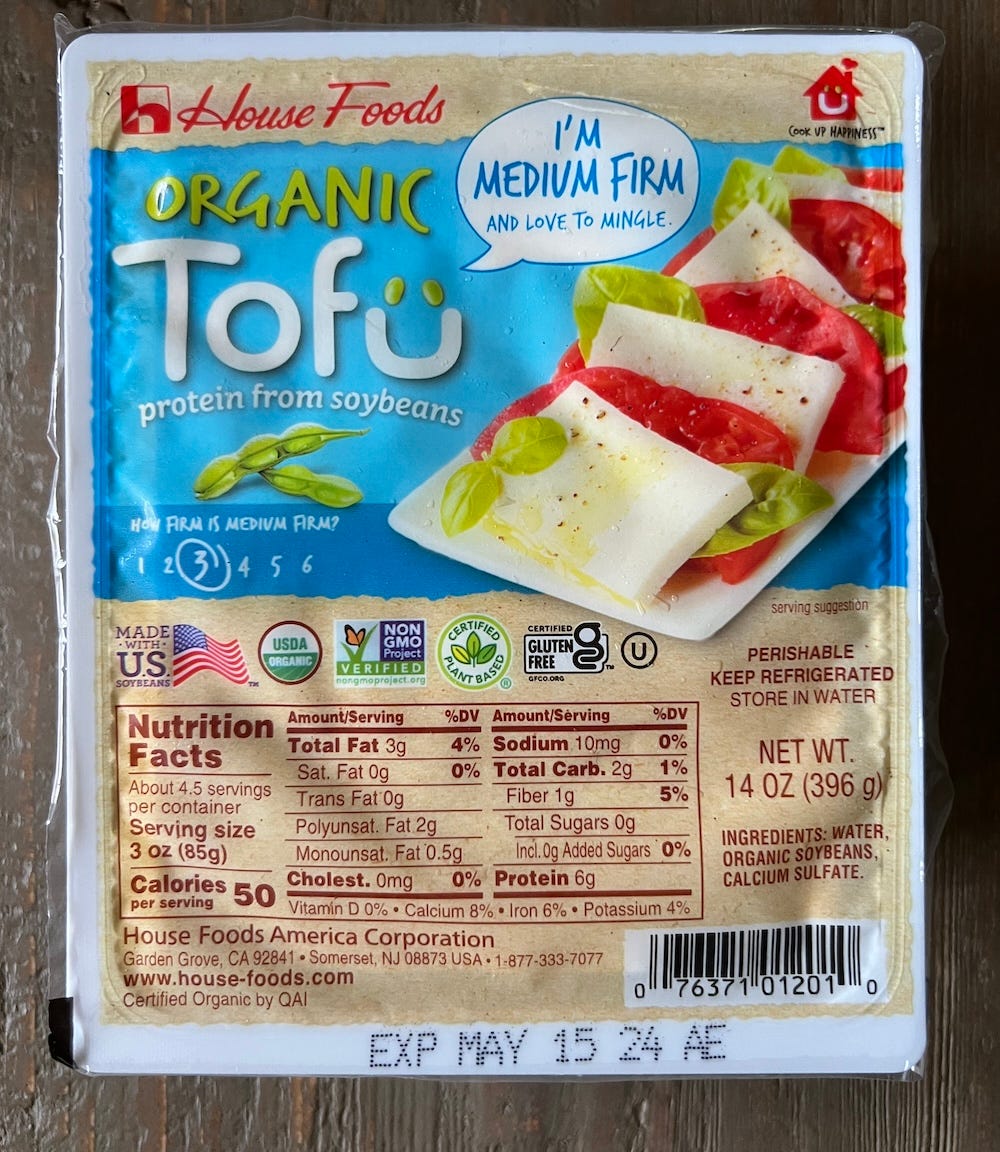How to Decipher Tofu Labels and Be a Better Cook
+ Ever-Green Vietnamese Birthday + 10K steps a day? + UK Tofu Tips + Tofu density, coagulant and weight
Hello everyone!
The week flew by (as usual) and despite feeling overwhelmed by my to-do list (who isn’t?), there were wonderful victories and developments, like:
Convincing my husband that we need luggage packing cubes for an upcoming Asia trip, then actually ordering some (so many sizes, colors, and functions!).
Reading that the 10,000 recommended daily number of steps for healthy living was likely used to sell pedometers. The number is fuzzy, as described in this JAMA article. Just get up and move! That’s the point.
Being featured in
’s newsletter. We had a raucous podcast conversation about diets, midlife and food writing careering. Listen to it here.Following up on the fried tofu posts 1 and post 2, I got tofu buying tips for Hannah in the UK! I wrote Fuchsia Dunlop, Chinese food authority and author of the recently released Invitation to a Banquet, who responded:
We don't have that much choice when it comes to tofu purveyors in the UK. I buy most of mine from Tofu King because they do various different kinds of tofu, including fresh tofu of various grades of firmness, sheets of pressed tofu and (if you can find it!) a delicious snack of fried tofu in chilli oil and spices. Kong Wah is also good: I use their fresh tofu for mapo tofu. Clean Bean does very nice artisanal, organic tofu: it's a bit firmer than I like for mapo tofu, but fresh and healthy, which is why I use it from time to time at home. I also use Taifun smoked tofu, which is really good.
And, I celebrated Ever-Green Vietnamese’s birthday. The book baby passed its 1-year-old mark! Thanks for being on board for Viet-style plant-based cooking. Here’s a fast replay of all the events.
The book came together during a time of personal loss in my family. Making and sharing the book helped me heal in many ways.
Thanks to all the folks near and far who’ve cooked up something from EGV thus far! Keep it up and share it with others.
If you have the book and enjoy it, please take a moment to give it a positive review at Amazon. (I know. But, reader reviews are rare these days so they matter lots. My sincerest appreciation for your considerations!)
Don’t yet have the book? Learn more about Ever-Green Vietnamese (EGV) here.
Tofu is the main protein in EGV but the book isn’t a tofu book. I couldn’t tuck in all my tips and tidbits for you to masterfully cook up tofu, so here’s my chance.
Whether you’re on the free or paid tofu train, you should know three things about tofu textures, coagulants, and package weight. And it’s all on the tofu label. In fine print. Here’s how to negotiate all the info on a tofu label:
(1) Really Dial In Tofu Texture and Density
A recipe will suggest a tofu density (firm, extra-firm, etc.) but when you’re shopping, there’s nuance. You can go off-road and choose something else. Here’s why . . .
Like sizing for denim jeans and underwear, there’s no standard for tofu textures. What’s firm in one brand may be extra-firm in another. There are subtle in-between situations too. You can guesstimate a tofu block’s texture by:
Grocery store: Korean markets tend to sell firmer tofu than Chinese, Vietnamese, and Japanese tofu. There are subtle tofu texture difference between cuisines. What’s labeled as “firm” tofu at a Korean market may be extra-firm tofu elsewhere. Chinese tofu firmness is between that of Korean and Japanese tofu. Japanese “regular” tofu may be firm or medium-firm tofu. Chinese “regular” tofu is mostly "medium-firm.” Viet-style tofu, mostly sold at Little Saigon markets, is akin to a chewy Chinese extra-firm tofu (see the coagulant discussion below).
Tofu shop customers: If you buy from a small local shop, monitor who their customers are. If a Chinese-own tofu shop sells a lot to non-Asian folks who like firm tofu, the shop’s “regular” tofu may be on the firm or extra-firm side.
Nutrition labels: Look at the protein count in the nutrition label to understand the tofu’s density. Consider the protein count for each standard 3-ounce serving. Here are my benchmarks for buying tofu that is neither too soft nor too hard for its class:

Plastic tub vs. vacuum sealed packaging: Any vacuum-sealed tofu will border on being super-firm. To be able to shipped in such packaging means that bean curd block better be super sturdy. It may be labeled “extra-firm” but check the protein count. Boxed tofu is always jello-like; I’d buy it for camping or emergencies because I don’t enjoy it.
Best-buy date: The further out the date, the fresher the tofu.
Season: Tofu textures vary by season, one tofu maker told me. I’ve not noticed that with big commercial brands. Perhaps in a small tofu shop? How wonderful is that? Tofu is indeed like bread baking.
Who produces America’s tofu?
One of the largest tofu makers in the United States is Pulmuone, a Korean-American company that produces Wildwood, Nasoya, Azumaya, Sansui, and Pulmuone (mostly sold at Korean and Chinese markets). I’m fairly sure “Pull-mu-one” is the private label producer of Trader Joe’s and Whole Foods tofu. They likely may make O Organic (Safeway) and Simple Truth (Kroger), as well.
I read lots of food labels. 😉
(2) Know How Coagulants Determine Density and Texture
For decades, readers of The Book of Tofu (1975) by William Shurtleff and Akiko Aoyagi, believed that Japanese tofu makers used nigari while Chinese tofu makers used gypsum as the coagulant. Focusing on Japanese foodways and the natural foods movement, the book was long considered the tofu reference work in America.
That cultural coagulant division held for years, with nigari (bittern, mostly magnesium chloride) perceived as being more natural. That’s likely because it looks like salt (below, left) in its dry state, which is crystalline and wet. Where does nigari come from? Basically salt ponds and the sea.
On the other hand, powdery gypsum (a natural mineral, calcium sulphate; above, right) likely looks suspect. It could be misunderstood as the gypsum employed for drywall, not the food-grade gypsum used in brewing beer and making tofu. It didn’t help that for years, the gypsum sold at Chinese markets had a slightly baby powder aroma.
I purchase food-grade gypsum online and home brewing supply shops.
Was the coagulant cultural division true? Is one better than the other?
Not according to the artisanal makers I met. Tofu makers in Japan and China picked what worked best for their customers and beans. Viet tofu shops in America favored acidic fermented whey for coagulation!
A summary of coagulant impact on tofu:
Nigari yields relatively firm tofu because the soy milk curds tend to form faster and are smaller; tofu coagulated with too much magnesium chloride can be bitter.
Gypsum facilitates bigger, beautiful curds. In my experience, tofu coagulated with calcium sulfate tends to be softer than tofu coagulated with nigari.
Fermented whey often yields tofu that’s slightly chewy.
Nowadays, you may see two coagulants listed on a tofu label, like above.
When reading labels, note that nigari and gypsum are not additives for enhancing shelf life or flavor. They facilitate coagulation.
If tofu contains a coagulant called glucono delta lactone (GDL, made by fermenting glucose, a carbohydrate) — the tofu will be on the quite firm side. GDL is often combined with other coagulants. Shelf-stable boxed tofus often contains GDL.
Tofu made with only GDL tends to be jello-like; the curds aren’t open and absorptive like what you get with nigari and/or gypsum. If you like firmer tofu, experiment with one coagulate some — but not all — GDL.
3) Don’t Fret about Tofu Package Weight
Here’s something that’s bugged me for years: a 14-ounce tub of tofu often contains a 16-ounce block. A 12-ounce package of tofu may contain 14-ounces. The block weight is never less than what’s stated on the label. As a recipe developer, I’ve stressed about it BUT you don’t have to!
If a recipe needs 16-ounces of tofu and all you see are 14-ounce packages, just buy it. You’ll be fine. You likely have a pound in that tub. Use a scale to double check, if you like. Don’t let this frustrate you as it has me.
There. I’ve made my tofu peace. Hopefully, these tips will help you tackle tofu with even greater confidence.
Next week, I have something really great for you to do with silken tofu. Can’t wait to let you in on it.











Congrats on EVG 1 year birthday! What a bonus of such a delightful book helping you through a challenging time.
I listened to your podcast with Sizemore twice! Once in segments (running errands) and the second time all at once (doing yard work).
You just blew my mind with all of the tofu info! 🤯 I’ve certainly noticed more customers asking about tofu lately, and I love it when I have the time to talk to them about it.
I don’t know why it thrills me to know my food heroes all seem to know each other! Andrea you always go the extra mile, above and beyond. You are truly wonderful.
🙏 I am off to Trader Joe’s for tofu☺️(btw, I took a screenshot of that handy chart. Great idea!)